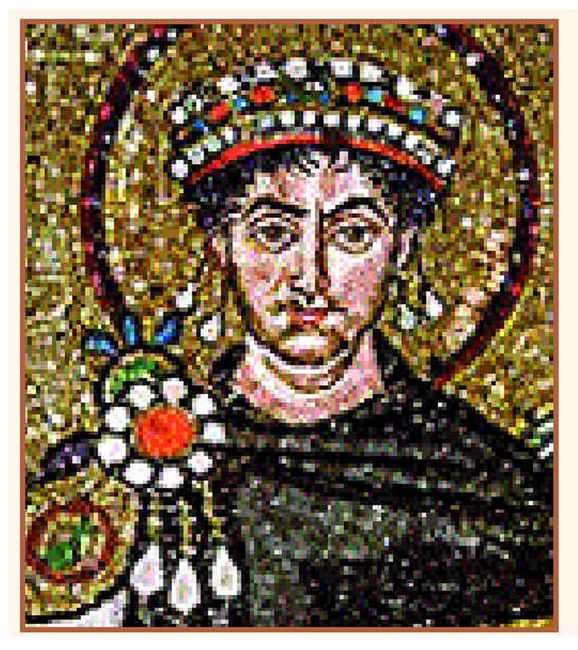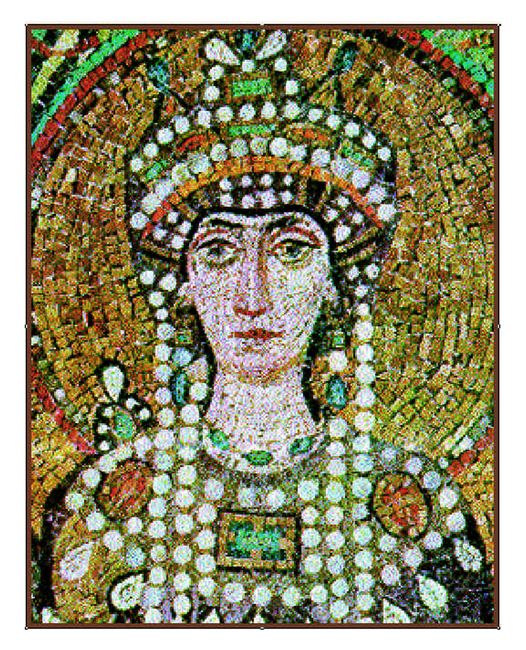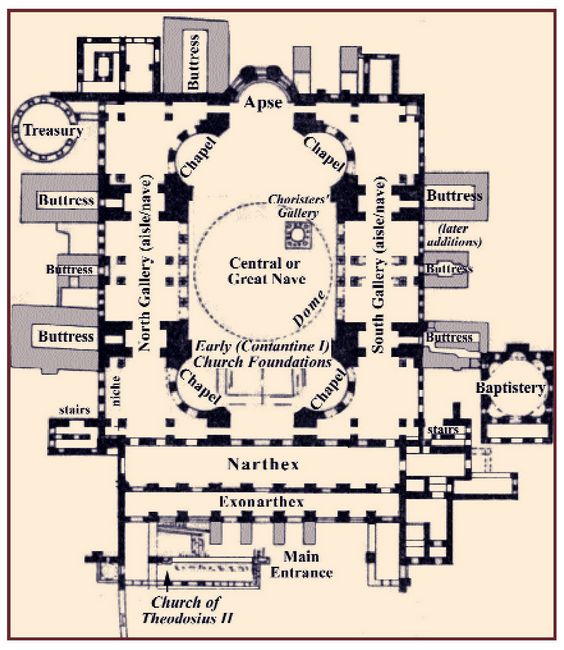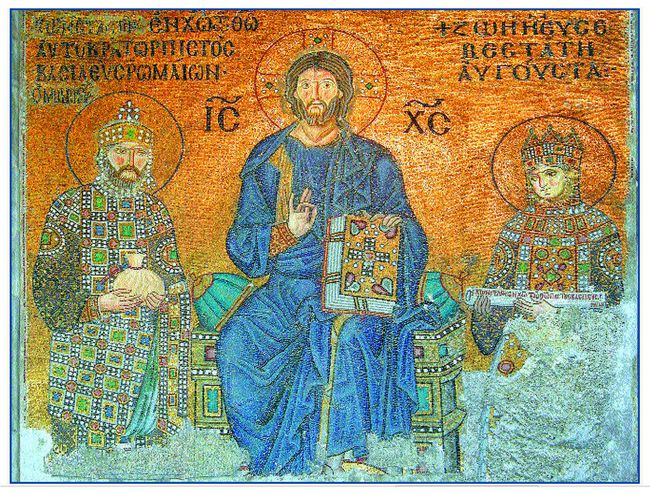|
James Allan Evans Professor Emeritus, University of British Columbia, Vancouver
.
Imperial favor had made Constantinople into a city greater than its nearest
rival in the Mediterranean world, Alexandria. The site which Constantine
had chosen for his “New Rome” was not ideal. It was arid and prone
to earthquakes. No olive trees could flourish there. It was fed by grain
shipped from Alexandria, diverted from supplies intended for Italy, and Italy
was left to support itself with grain shipments from Sicily and North Africa.
But the cargo ships that sailed from Alexandria to Constantinople encountered
head winds and contrary currents in the Hellespont which could make it impossible
to approach the wharfs. The Emperor Justinian (527-565) built granaries at
the entrance to the Hellespont on the island of Tenedos to store the grain
brought from Egypt until there was a favorable wind, but that meant that
stevedores at Tenedos had to unload the grain sacks, store them until the
weather changed, and then reload them. It was back-breaking work, and must
have provided illicit feasts for rats and other rodents. Yet Constantinople
grew into a splendid city of about half a million persons in Late Antiquity,
at a time when Paris, Milan, and Ravenna were large villages and Rome was
a decaying museum-without-walls.
In the southeast corner of the city was the Great Palace. Like the Kremlin
in Moscow, it was not a single building, but rather a group of them surrounded
by a wall and entered by a magnificent gateway. Opposite the palace, across
a square called the Augustaeum, was the cathedral church, Hagia Sophia, and
to the west of the palace was the Hippodrome and the Baths of Zeuxippus.
The Hippodrome is in ruins now, but on the seaward side we can still see
some of its massive substructures and in what remains of the arena we may
view some of the monuments that once adorned the spina, including a bronze
serpent column taken from Delphi, where Pausanias, the Spartan who led the
Greeks to victory over the Persians at Plataea in 479 BC, had dedicated it
as an offering to Apollo. The main street of Istanbul, the Divanyolu, is
the main street of Constantine’s city, the Mese. It runs past the “Burnt Column,” all that remains of a pillar which once held a
bronze figure of Constantine which was a recycled statue of Apollo, and marked
the “Oval Forum” where there stood the bronze Athena Promachos
statue by Pheidias which had once looked over ancient Athens from the Acropolis.
Constantine had adorned his city with works of art taken from various sites
 in Greece, and his successors, down to the 6th century, followed his example.
Beyond the Oval Forum, the Mese continued west and one of its branches led
to the Golden Gate which pierced the great Theodosian walls that were never
broken until the Turks attacked in 1453. in Greece, and his successors, down to the 6th century, followed his example.
Beyond the Oval Forum, the Mese continued west and one of its branches led
to the Golden Gate which pierced the great Theodosian walls that were never
broken until the Turks attacked in 1453.
Fig.1: Roman aqueduct in Istanbul, dating from the 3-4th c AD (photo: Athena Review). It was a busy, disorderly city, full of life and at a time when older cities
of the empire were shrinking, it continued to grow. The porticoes lining
either side of the Mese were full of merchants’ stalls. Nearest the
imperial palace were the perfumers, for the scent from their shops was considered
suitable for the sacred persons of the emperor and empress. Further along
the Mese were silversmiths and money-changers and the Oval Forum of Constantine
was a center of the fur trade. Near the Baths of Zeuxippus stood the “House
of Lamps,” so-called because its windows were lamp-lit at night, and
there the finest dyed silks were on display. The rich lived in palaces, and
the poor eked out an existence on the streets. The numerous churches advertised
the piety of the wealthy class, but the poor supplied the mob which was forever
restless and easily ignited by religious disputes.
Second only to theology and its controversies, the crowd loved chariot-racing.
In the Hippodrome, four chariot factions competed, marked by their colors,
Red, White, Blue, and Green. Their fans sat in designated sections in the
Hippodrome while the emperor had a loge on its east side, next to the imperial
palace. The crowd did not always come to the Hippodrome merely to cheer the
charioteers. This was also a place where it could voice discontents and shout
complaints, and the emperor, using a herald with a trained voice, could reply.
There was a rough-and-ready democracy here, where emperors encountered public
opinion, and revolutions might be born.
In 491, the Emperor Zeno the Isaurian died. He had left a brother who expected
to succeed to the throne, but Ariadne, Zeno’s widow, married an elderly
bureaucrat, Anastasius. The Isaurians whom Zeno had
favored were outraged, but Anastasius banished Zeno’s brother to upper
Egypt where he died of starvation and by 497, he had quelled the Isaurians
in the capital and put paid to notions of independence in Isauria itself.
The patriarch was also unhappy at Ariadne’s choice, for Anastasius was
a known Monophysite sympathiser, and as part of the coronation ceremony,
the patriarch insisted that he take a coronation oath to uphold orthodoxy.
But Anastasius was an able administrator, though once the Constantinople
mob almost dethroned him when he introduced an addition to the liturgy in
Hagia Sophia that smacked of Monophysitism. He was forced to appear in the
Hippodrome, repentant, bareheaded without his crown, when mob sentiment turned
to pity and he survived. But his attempts to negotiate a solution to the
schism with Rome came to nothing. Rome would accept nothing less than the
Chalcedonian Creed and unless Anastasius surrendered, the pope would not
lift the excommunication.
Then in 518, Anastasius died suddenly and left a vacuum of power. His obvious
heir was his nephew, a thorough mediocrity, but he was in Antioch commanding
the armed forces in the east. It was up to the Constantinople senate to make
the choice, and the picturesque but powerless body was unused to making decisions
about anything. Yet it met in the palace with the patriarch and the chief
bureaucrats and negotiated, while the people gathered in the Hippodrome and
waited impatiently. With negotiations dragging on, the situation threatened
to get out of hand and a panicked senate opted for Justin, the commander
of the effective palace guard known as the Excubitors. Justin had risen through
the ranks and married a former slave, Lupicina, whom he had purchased as
his mistress. The new emperor was presented to the Hippodrome crowd which
raised the salute: “Justin, may you be victorious!” Lupicina, adopting
the more suitable name of Euphemia, became empress.
Justin also adopted his nephew, Justinian, who later inherited the throne
and provided the expertise that his uncle lacked. But both men agreed that
the schism with Rome must end. That meant surrendering to Rome’s demands,
and Pope Hormisdas was adamant. He demanded that the emperors Zeno and
Anastasius, and the patriarchs who cooperated with them be anathematized.
Monophysitism was to be outlawed and its followers persecuted if they would
not recant. In cooperation, Justin ousted Monophysite bishops and monks from
their sees and monasteries. The patriarch of Antioch, Severus, the leading
Monophysite of the day and Anastasius’ protegé, avoided arrest
by secretly fleeing to Alexandria. Only Egypt remained a safe haven for the
Monophysites, for though the pope urged Justin to extend his persecution
there too, Justin knew how much Constantinople depended on cargoes of grain
from the Nile Valley.
At Amid, modern Diyarbakir in Turkey, monks were driven from their monastery
and nearly died of privation. In their distress they turned to one friend
at court who they knew favored their theology. That was Justinian’s
mistress, an ex-actress named Theodora who had been converted to Monophysitism
in Alexandria, possibly by the patriarch Timothy IV himself. When the monks
banished from Amid appealed to Theodora, she urged Justinian to approach
Justin, and the monks were allowed to go to Egypt and find refuge there.
It was Theodora’s first intervention on behalf of the Monophysites.
In 527, Euphemia (formerly Lupicina) was dead for several years and Justin,
by now senile and suffering from an old wound he had received as a soldier,
appointed Justinian co-emperor and four months later, he died. Justinian
and Theodora became emperor and empress. More than most imperial marriages,
it was a union of equals, for Justinian valued Theodora’s advice, and
Theodora did not hesitate to oppose him when she thought fit, though her
loyalty to her husband was never in doubt. On matters of theology, they agreed
to disagree. But together they presided over the most brilliant period of
early Byzantium, which began with a burst of optimism when it seemed possible
to restore the dominion of the old Roman Empire. Byzantine armies reconquered
Africa, Italy, and part of Spain. But by the end of Justinian’s reign
the mood had darkened. War had depleted the empire’s resources, plague
had cut the population by forty per cent, and the division between the
Monophysites and the Chalcedonian Creed orthodoxy was on the way to becoming
permanent.
Three buildings survive to attest the magnificence of Justinian’s reign.
One is the church of San Vitale in Ravenna. Ravenna, the last refuge of the
emperors of the Western Roman Empire, had become the capital of the Ostrogothic
kingdom of Theodoric, who had made himself master of Italy during Zeno’s
reign in Constantinople. Byzantine forces led by Justinian’s most famous
general, Belisarius, took Ravenna in 540, and the city was to become the
seat of the Byzantine exarch. The construction of San Vitale began while
Ravenna still belonged to the Ostrogoths, and a local banker paid for it,
 but it was not dedicated until 547, a year before Theodora died of cancer.
In its chancel, two splendid mosaics face each other on the side walls. One
shows Justinian and his attendants (fig.3). The other shows Theodora surrounded by
her ladies (fig.4). Justinian looks vigorous. Theodora looks severe; the onlooker
can perhaps recognize in her face traces of pain from the cancer which would
soon kill her. Neither Justinian nor Theodora ever came to Ravenna, but this
is where we feel closest to their ghosts. but it was not dedicated until 547, a year before Theodora died of cancer.
In its chancel, two splendid mosaics face each other on the side walls. One
shows Justinian and his attendants (fig.3). The other shows Theodora surrounded by
her ladies (fig.4). Justinian looks vigorous. Theodora looks severe; the onlooker
can perhaps recognize in her face traces of pain from the cancer which would
soon kill her. Neither Justinian nor Theodora ever came to Ravenna, but this
is where we feel closest to their ghosts. Fig.3: Detail of mosaic of Justinian in the Church of St. Vitale in Ravenna, AD 547 (photo: Athena Review).
In Istanbul, the church of SS. Sergius and Bacchus is a twin of San Vitale.
It is now a mosque, and the vibrations of the elevated railway that runs
close by it are slowly cracking the dome. But inside the church on the
entablature under the dome there c an still be seen the inscription hailing
Theodora as “God-crowned whose mind is adorned with piety and whose
constant toil lies in unsparing efforts to sustain the needy.” The church
stood close to the Palace of Hormisdas where Justinian and Theodora lived
while Justin was still alive, and after they moved to the Great Palace, Theodora
filled their former home with Monophysite holy men who flocked to Constantinople
to seek her protection. Saints Sergius and Bacchus was probably their church. an still be seen the inscription hailing
Theodora as “God-crowned whose mind is adorned with piety and whose
constant toil lies in unsparing efforts to sustain the needy.” The church
stood close to the Palace of Hormisdas where Justinian and Theodora lived
while Justin was still alive, and after they moved to the Great Palace, Theodora
filled their former home with Monophysite holy men who flocked to Constantinople
to seek her protection. Saints Sergius and Bacchus was probably their church.
Fig.4: Detail of mosaic of Theodora in the Church of St. Vitale in Ravenna, AD 547 (photo: Athena Review). But the great monument of Justinian’s reign is Hagia Sophia which still
stands intact though it shows the scars of a turbulent history (figs 5-6). Behind it
lies a story. Once he was emperor, Justinian determined to enforce law and
order and to suppress rioting. In January of 532, one group set off a week
of riots and arson that destroyed whole regions of the city and would have
driven Justinian from the throne except that Theodora kept her nerve in the
crisis, and the soldiers that were still loyal cornered the rioters in the
Hippodrome and massacred them. Justinian emerged from the riots stronger
than ever, determined to remake the city and leave his mark on it. The
conflagration destroyed Hagia Sophia, and Justinian was anxious to replace
it with a structure that would glorify his reign.
 Hagia Sophia tested the limits of contemporary civil engineering. It is a
great dome placed on a modified basilical church. The first dome that was
built was breathtaking but the outward thrust was too great and the huge
piers that held it up began to tip outwards.
Hagia Sophia tested the limits of contemporary civil engineering. It is a
great dome placed on a modified basilical church. The first dome that was
built was breathtaking but the outward thrust was too great and the huge
piers that held it up began to tip outwards.
Fig.5: Plan of Hagia Sophia. A severe earthquake smote
Constantinople in December of 557, driving the people in terror into the
streets where they shivered in a sleet storm until morning, when the light
revealed a crack in Hagia Sophia’s dome. Stone masons from Isauria set
to work repairing it, but suddenly next year, on 7 May, they had to scramble
for safety as the eastern section came tumbling down. The dome was rebuilt,
making it 7 meters higher, and though there have been later repairs and
reconstructions, this is the dome that still impresses us in modern Istanbul.
Hagia Sophia has served as a mosque and is now a museum, but it still proclaims
the greatness of Justinian’s empire.
Yet the religious schism remained intractable. Once Byzantium overthrew the
Ostrogothic kingdom in Italy and had physical control of Rome, the popes
no longer found it so easy to defy the emperor, and though Justinian continued
to respect the papacy, Theodora regarded the popes as recalcitrant prelates
who should be forced to soften their defense of the Chalcedonian Creed. But
th ough she seconded her husband’s efforts to reconcile the Monophysites
and the Chalcedonians, she cannot have been too sanguine. ough she seconded her husband’s efforts to reconcile the Monophysites
and the Chalcedonians, she cannot have been too sanguine. Fig.6: An 11th century mosaic from Hagia Sophia, showing Christ seated between the Emperor John IX and his wife (photo: Athena Review). In 541, an Arab
client king of the Ghassanid tribe which guarded the south Syrian frontiers
for the empire, asked Theodora for an ordained Monophysite bishop to minister
to his people. Bubonic plague was already killing thousands in Egypt and
was moving into Syria; next year it would reach Constantinople and cut its
population in half. Antioch lay in ruins; the Persians had sacked it in 540,
and were still ravaging the eastern provinces. Whatever private hesitations
Theodora may have had, the imperial government was in no position to refuse
a valuable ally what he wanted. Theodora provided the Ghassanid emir with
two bishops, and unwittingly she became the godmother of a separate Monophysite
church with its own hierarchy. Thereafter the quest to reunite Christendom
with one statement of faith was to grow increasingly futile.
This article appears on pp.16-25 in Vol.3, No.1 of Athena
Review.
.
|
|